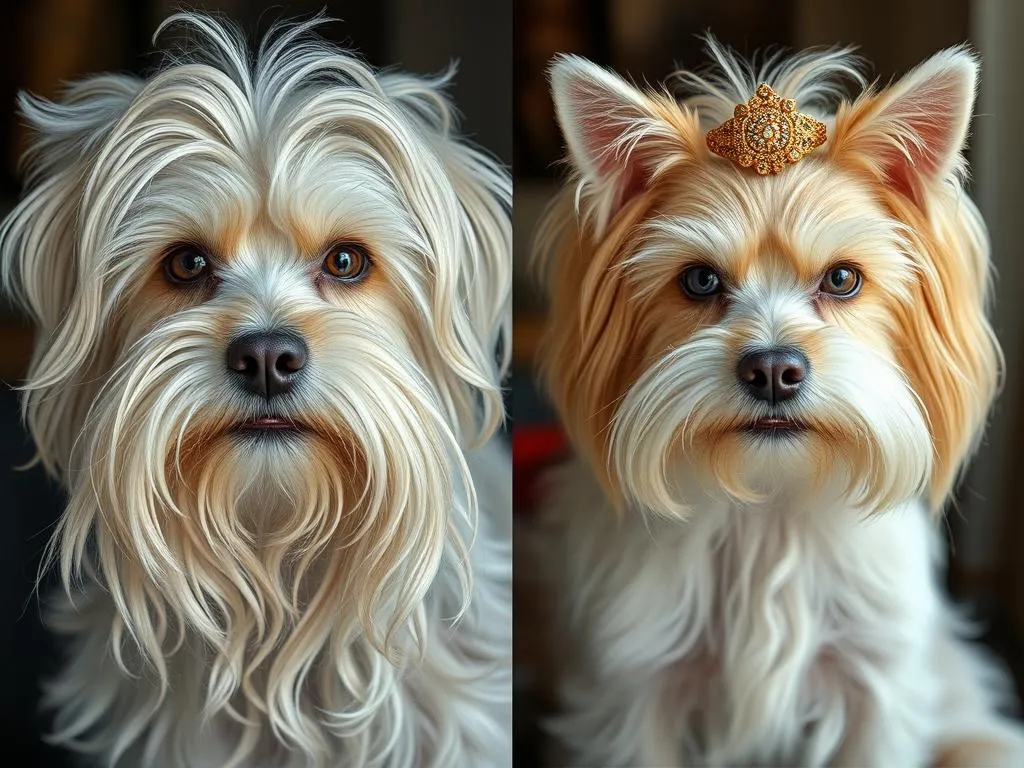
Introduction
The Maltese breed is a beloved small dog known for its charming personality and beautiful, silky white coat. Originating from the Mediterranean region, these dogs have captured the hearts of many dog lovers, becoming a popular choice for families and individuals alike. Understanding the differences between male Maltese vs female Maltese is crucial for prospective owners, as it can influence your choice and ensure a perfect match for your lifestyle. This article will explore the characteristics, behavioral traits, health considerations, and training needs of both male and female Maltese, helping you make an informed decision.
Overview of the Maltese Breed
History and Origin
The Maltese breed boasts a rich history that dates back over 2,000 years. Originally bred for companionship, these dogs were favorites among royalty and nobility. Their lineage can be traced to the island of Malta, where they were cherished as lap dogs. The breed has gained significant recognition from kennel clubs worldwide, establishing itself as a standard for small companion breeds.
Physical Characteristics
Maltese dogs typically weigh between 4 to 7 pounds and stand about 8 to 10 inches tall at the shoulder. Their most distinguishing feature is their long, flowing white coat, which requires regular grooming to prevent matting. Maltese come in various shades, but pure white is the most prized. Regular grooming, including brushing and bathing, is essential to maintain their luxurious appearance.
Temperament and Behavior
Maltese dogs are known for their affectionate and playful nature. They are intelligent, eager to please, and generally get along well with children and other pets. Their lively personality makes them a great addition to any household, but they do require social interaction and mental stimulation to thrive.
Male Maltese Characteristics
Physical Attributes
Male Maltese dogs tend to be slightly larger than their female counterparts, typically weighing between 5 to 8 pounds. Their grooming needs mirror those of females, requiring regular brushing to keep their coat in top condition. However, males may exhibit more pronounced hair growth around their faces and bodies.
Temperament and Personality Traits
When it comes to personality, male Maltese are often more playful and spirited than females. They tend to have higher energy levels and may require more exercise. Males can be more affectionate and may form stronger bonds with their owners, seeking attention and companionship.
Health Considerations
Common health issues affecting male Maltese include dental problems, patellar luxation, and heart issues. The average lifespan of a male Maltese ranges from 12 to 15 years, and regular veterinary check-ups are crucial for preventive care.
Training and Socialization
Training male Maltese can be relatively straightforward due to their intelligence; however, they may also display stubbornness. Socialization is essential for male Maltese, as they can be territorial and may exhibit protective behaviors. Early exposure to different environments, people, and pets can help mitigate these tendencies.
Female Maltese Characteristics
Physical Attributes
Female Maltese dogs generally weigh between 4 to 7 pounds, similar to males but often with a more petite appearance. Their grooming needs are the same as males, but females may require special attention if they are not spayed, as they can experience seasonal shedding.
Temperament and Personality Traits
Female Maltese often exhibit nurturing instincts and may be more sensitive than males. They tend to be calm and gentle, making them great companions for families and individuals seeking a quieter pet. While they enjoy playtime, females may be less rambunctious than males and prefer cuddling and companionship.
Health Considerations
Female Maltese are prone to similar health issues as males, including dental problems and heart conditions. However, they may also face reproductive health issues if not spayed, such as pyometra and mammary tumors. Their lifespan is generally comparable to that of males, averaging 12 to 15 years with appropriate care.
Training and Socialization
Training female Maltese can be slightly easier due to their generally compliant nature. They respond well to positive reinforcement and are eager to please their owners. Socialization is still essential, particularly to build their confidence and prevent shyness around unfamiliar people and animals.
Key Differences Between Male and Female Maltese
Physical Differences
While both male and female Maltese share similar size ranges, males can appear bulkier due to their slightly larger build. Grooming variations also exist; males may have thicker coats around the neck and face, requiring diligent grooming to prevent tangles.
Behavioral Differences
In general, male Maltese are more energetic and playful, often engaging in more vigorous play than females. Females, on the other hand, may demonstrate a more nurturing side, enjoying quiet time and cuddling over high-energy activities. These differences can influence your choice based on your lifestyle and preferences.
Health and Lifespan Differences
Both male and female Maltese face similar health challenges, but females may experience unique reproductive health issues. The decision to spay or neuter can impact health; spayed females may have reduced risks of certain cancers, while neutered males can avoid prostate issues. Lifespan expectations are similar for both genders, emphasizing the importance of preventive health care.
Training and Socialization Styles
Training approaches for males may need to be more assertive due to their occasionally stubborn nature, while females often respond well to gentle guidance. Social behaviors can also differ; males may show more territorial tendencies, while females might be more adaptable in new environments.
Choosing the Right Maltese for You
Lifestyle Considerations
When selecting between a male Maltese vs female Maltese, consider your lifestyle. If you lead an active life and enjoy playing with your dog, a male might be the better fit. Conversely, if you prefer a more relaxed companion who enjoys cuddling, a female could be ideal.
Family Dynamics
Assess your family dynamics when choosing a Maltese. If you have children or other pets, consider how a male or female might interact with them. Males might be more boisterous, while females may exhibit more nurturing behaviors, which can influence family interactions.
Personal Preferences
Your personal preferences play a crucial role in choosing a Maltese. Some people are drawn to the playful nature of males, while others may appreciate the gentler demeanor of females. Emotional factors, such as bonding styles and attachment preferences, will also guide your decision.
Conclusion
In summary, understanding the differences between male Maltese vs female Maltese is essential for any prospective dog owner. The choice between a male or female Maltese can significantly impact your experience as a pet owner, from training and socialization to health considerations. Whether you choose a playful male or a nurturing female, the key is to ensure that your new companion aligns with your lifestyle and family dynamics. Remember, responsible pet ownership includes being informed about breed traits and characteristics, ensuring a happy and fulfilling relationship with your Maltese.
FAQs
What is the average lifespan of a Maltese?
The average lifespan of a Maltese is typically between 12 to 15 years, depending on genetics, health care, and overall lifestyle.
Are male Maltese more aggressive than females?
Male Maltese may exhibit territorial behaviors and can sometimes be more playful, but aggression is not a universal trait and can largely depend on individual temperament and socialization.
How do I choose the best Maltese for my family?
Evaluate your lifestyle, family dynamics, and personal preferences. Consider the energy levels and temperament of both male and female Maltese to find the best fit.
What common health issues should I watch for in Maltese dogs?
Common health issues in Maltese include dental problems, patellar luxation, and heart conditions. Regular veterinary check-ups and preventive care are crucial for maintaining their health.









